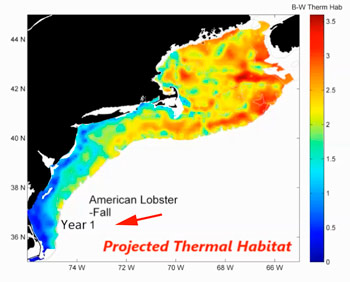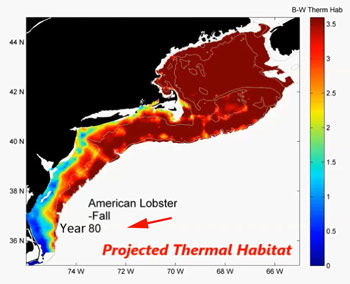Marine Species Distribution Shifts Will Continue Under Ocean Warming
Changes impact local fishing communities,
resource management
Scientists using a high-resolution global climate model and historical observations of species distributions on the Northeast U.S. Shelf have found that commercially important species will continue to shift their distribution as ocean waters warm two to three times faster than the global average through the end of this century. Projected increases in surface to bottom waters of 6.6 to 9 degrees F (3.7 to 5.0 degrees Celsius) from current conditions are expected.
The findings, reported in Progress in Oceanography, suggest ocean temperature will continue to play a major role in where commercially important species will find suitable habitat. Sea surface temperatures in the Gulf of Maine have warmed faster than 99 percent of the global ocean over the past decade. Northward shifts of many species are already happening, with major changes expected in the complex of species occurring in different regions on the shelf, and shifts from one management jurisdiction to another. These changes will directly affect fishing communities, as species now landed at those ports move out of range, and new species move in.
Researchers looked at species distributions in spring and fall in the Gulf of Maine on the northern part of the Northeast Shelf and those on the southern end, from Georges Bank to the Mid-Atlantic Bight. They also examined what the shifting distributions might mean for fishing communities by looking at the current and potential future distance between the main fishing port in each state and the center of the distribution of suitable thermal area for the top-landed species by weight in each state.
Key northern species including Acadian redfish, American plaice, Atlantic cod, haddock, and thorny skate may lose thermal habitat, while spiny dogfish and American lobster may gain. Projected ocean warming in the Gulf of Maine may create beneficial conditions for American lobster populations, and they may continue to be accessible to fishing ports in the region.
In contrast, species like monkfish, witch flounder, white hake and sea scallops may remain accessible to major local fishing ports but could experience strong declines in habitat due to ocean warming. Atlantic cod, which is at the southern end of its range, may find suitable thermal habitat off the shelf entirely or in more northern waters in Canada.
In states south of New York, the distance to the centers of species distribution from ports may increase for some species, including summer flounder, which is currently the third most-landed species in Virginia. In North Carolina, the distance from ports to the center of distribution may increase for all six of the top landed species. Among the top six species landed in Virginia, only Atlantic croaker and striped bass are projected to have more suitable habitat.
“Warming waters may have a positive effect on smooth dogfish, Atlantic croaker, and striped bass in the southern part of the Northeast Shelf, with increases in suitable habitat in terms of area and species abundance, “ Kleisner said. “But these species are also shifting northward and the bulk of the biomass of some species may be further from the main ports in southern states, making it more costly for fishermen to access these species. Conversely, as species move into new regions, fishermen may have new opportunities.”


